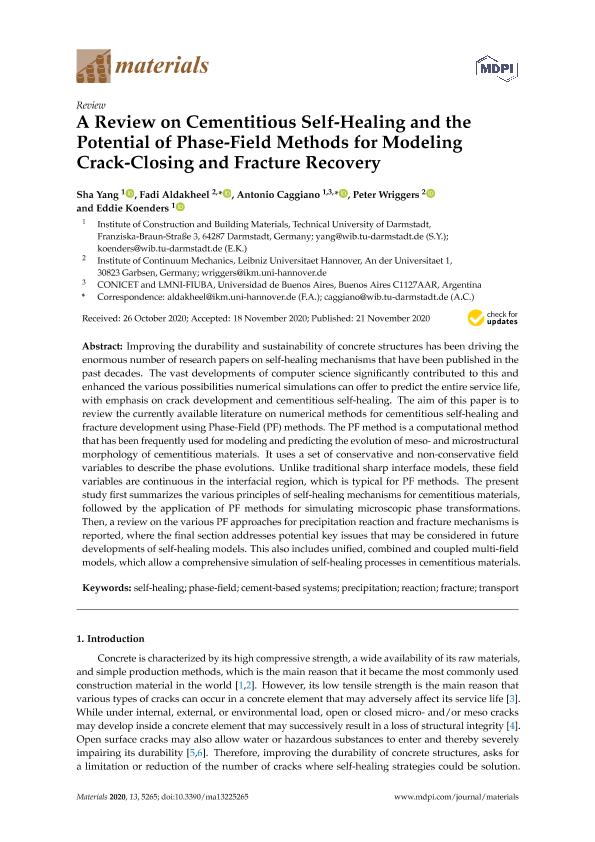Mostrar el registro sencillo del ítem
dc.contributor.author
Yang, Sha
dc.contributor.author
Aldakheel, Fadi
dc.contributor.author
Caggiano, Antonio

dc.contributor.author
Wriggers, Peter
dc.contributor.author
Koenders, Eddie
dc.date.available
2021-05-21T15:11:13Z
dc.date.issued
2020-11
dc.identifier.citation
Yang, Sha; Aldakheel, Fadi; Caggiano, Antonio; Wriggers, Peter; Koenders, Eddie; A Review on Cementitious Self-Healing and the Potential of Phase-Field Methods for Modeling Crack-Closing and Fracture Recovery; Molecular Diversity Preservation International; Materials; 13; 22; 11-2020; 1-31
dc.identifier.issn
1996-1944
dc.identifier.uri
http://hdl.handle.net/11336/132498
dc.description.abstract
Improving the durability and sustainability of concrete structures has been driving the enormous number of research papers on self-healing mechanisms that have been published in the past decades. The vast developments of computer science significantly contributed to this and enhanced the various possibilities numerical simulations can offer to predict the entire service life, with emphasis on crack development and cementitious self-healing. The aim of this paper is to review the currently available literature on numerical methods for cementitious self-healing and fracture development using Phase-Field (PF) methods. The PF method is a computational method that has been frequently used for modeling and predicting the evolution of meso-and microstructural morphology of cementitious materials. It uses a set of conservative and non-conservative field variables to describe the phase evolutions. Unlike traditional sharp interface models, these field variables are continuous in the interfacial region, which is typical for PF methods. The present study first summarizes the various principles of self-healing mechanisms for cementitious materials, followed by the application of PF methods for simulating microscopic phase transformations. Then, a review on the various PF approaches for precipitation reaction and fracture mechanisms is reported, where the final section addresses potential key issues that may be considered in future developments of self-healing models. This also includes unified, combined and coupled multi-field models, which allow a comprehensive simulation of self-healing processes in cementitious materials.
dc.format
application/pdf
dc.language.iso
eng
dc.publisher
Molecular Diversity Preservation International

dc.rights
info:eu-repo/semantics/openAccess
dc.rights.uri
https://creativecommons.org/licenses/by-nc-sa/2.5/ar/
dc.subject
CEMENT-BASED SYSTEMS
dc.subject
FRACTURE
dc.subject
PHASE-FIELD
dc.subject
PRECIPITATION
dc.subject
REACTION
dc.subject
SELF-HEALING
dc.subject
TRANSPORT
dc.subject.classification
Ingeniería Civil

dc.subject.classification
Ingeniería Civil

dc.subject.classification
INGENIERÍAS Y TECNOLOGÍAS

dc.title
A Review on Cementitious Self-Healing and the Potential of Phase-Field Methods for Modeling Crack-Closing and Fracture Recovery
dc.type
info:eu-repo/semantics/article
dc.type
info:ar-repo/semantics/artículo
dc.type
info:eu-repo/semantics/publishedVersion
dc.date.updated
2021-03-26T19:52:14Z
dc.identifier.eissn
1996-1944
dc.journal.volume
13
dc.journal.number
22
dc.journal.pagination
1-31
dc.journal.pais
Suiza

dc.description.fil
Fil: Yang, Sha. Universitat Technische Darmstadt; Alemania
dc.description.fil
Fil: Aldakheel, Fadi. Leibniz Universitat Hannover.; Alemania
dc.description.fil
Fil: Caggiano, Antonio. Consejo Nacional de Investigaciones Científicas y Técnicas. Oficina de Coordinación Administrativa Houssay. Instituto de Tecnologías y Ciencias de la Ingeniería "Hilario Fernández Long". Universidad de Buenos Aires. Facultad de Ingeniería. Instituto de Tecnologías y Ciencias de la Ingeniería "Hilario Fernández Long"; Argentina
dc.description.fil
Fil: Wriggers, Peter. Leibniz Universitat Hannover.; Alemania
dc.description.fil
Fil: Koenders, Eddie. Universitat Technische Darmstadt; Alemania
dc.journal.title
Materials
dc.relation.alternativeid
info:eu-repo/semantics/altIdentifier/url/https://www.mdpi.com/1996-1944/13/22/5265
dc.relation.alternativeid
info:eu-repo/semantics/altIdentifier/doi/http://dx.doi.org/10.3390/ma13225265
Archivos asociados
